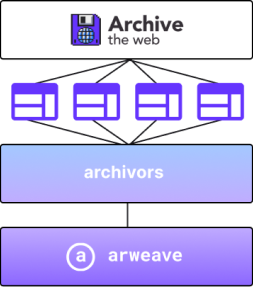Archive what matters to you
An open & permanent public web archive for everyone
Let's safeguard the web and our digital history. Explore the open and decentralized archive and begin archiving your favorite content - from government speeches and news articles to social media posts and cat memes!

The average website is altered or deleted after 92 days.

Content is censored
Censorship occurs when governments or private groups suppress words, images, and ideas that are "offensive" and impose this on others.
See example: FIFA world cup coverage in China
In China, during the FIFA World Cup 2022 in Qatar, footage of maskless crowds in the stadiums was not aired on TV because it contradicted China's zero-covid lockdown protocols.

Opinions change
Sometimes, online information is deleted or altered due to a change in leadership.
See example: British Conservative Party
This can occur when there is a change in government. In 2013, the British Conservative Party abruptly deleted ten years' worth of speeches and press releases from their website. They also attempted to prevent search engines from being able to access the deleted files by updating the robots.txt files.

Organizations close
Companies can shut down and lose the data you entrusted them with keeping.
See example: Yahoo! closure of GeoCities
In 2009, Yahoo! closed GeoCities, a free web hosting platform popular for personal websites, fan sites, and other online communities. When it was shut down, millions of files and user accounts were deleted. Despite efforts by the Internet Archive to preserve as much of the GeoCities content as possible, a significant amount of data was lost forever.

Links rot
Link rot occurs when the hyperlinked text no longer leads to the original site or file.
See example: U.S. Supreme Court references
A 2022 study found that over 66.5% of links to sites in the last nine years have been lost. An earlier study from 2014 found that 70% of links in legal journals and 50% of URLs cited in the U.S. Supreme Court decisions no longer worked.

Hosting is unpaid
Hosting services can be left unpaid and content abandoned. This can sometimes happen due to company shutdowns and bankruptcies.
See example: Coachella lifetime passes & FTX
The artwork for Coachella NFTs, including the lifetime passes which sold for six figures, is unavailable because of server issues in the wake of the FTX collapse and bankruptcy. Many other projects launched on this platform are having similar problems.

Servers go down
In a company's routine operations, servers can sometimes go down, causing data loss on small and large scales.
See example: MySpace loses 50 million songs
One extreme example was the massive data loss suffered by Myspace in 2019. Images, videos, and audio files uploaded before 2016 were likely lost due to this incident. This loss included 12 years of music uploads, totalling 50+ million songs from 14 million artists. They claimed it occurred due to server migration.

Introducing an open archive
Archive the Web is an open-source tool that allows you to set up automated website archiving stored on Arweave. Our mission is to create a decentralized backup of the world wide web and to make it accessible to everyone.
You can easily select the content you want to include in the archive, and our platform will take care of the rest. We believe in open access to information, so our platform is open by default, allowing anyone to access and use the archive.
You can easily select the content you want to include in the archive, and our platform will take care of the rest. We believe in open access to information, so our platform is open by default, allowing anyone to access and use the archive.


How it works
1 Find a website to preserve.
2 Select a duration and frequency for snapshots.
3 Pay the storage fee.
That's all! The snapshots will be automatically saved on the permaweb and added to the open and decentralized archive, where they will be accessible to anyone who wants to explore the history of the web.
Archive what matters to you
Archive the Web is open to everyone, regardless of political, religious, or ideological beliefs. We aim to work together and archive a diverse range of information, from news and important artworks to public-facing governmental information. With this approach, we can create a resilient and substantial archive of our digital footprint that will be preserved for future generations.


Built to last
We are committed to preserving the web and its rich history for future generations. That's why we use Arweave, a permanent data storage protocol that ensures all website snapshots are stored in an immutable and community-owned web, known as the permaweb. Data added to Arweave is replicated among hundreds or thousands of computers or "miners" making it resilient and easily retrievable.
To permanently save data, the Arweave network charges an upfront fee, which is calculated based on conservative estimates around price reductions for storage over time. This fee incentivizes the miners to continue storing the data for at least 200 years, ensuring that website snapshots are preserved for future historical purposes.
To permanently save data, the Arweave network charges an upfront fee, which is calculated based on conservative estimates around price reductions for storage over time. This fee incentivizes the miners to continue storing the data for at least 200 years, ensuring that website snapshots are preserved for future historical purposes.
Frequently Asked Questions
How does Archive the Web work?
1. Find a website you want to archive permanently.
2. Enter the URL and snapshot settings on Archive the Web. You can set up long-term archiving, which automatically takes snapshots at pre-set intervals (e.g., every 24 hours).
3. Pay the storage fee calculated by the Arweave network. You will be able to pay this fee using a variety of methods, including Metamask, Wallet Connect, or Arweave directly. The fee can be paid using various cryptocurrencies, such as AR, ETH, and ERC-20s, on multiple blockchain networks (e.g., Polygon, Arbitrum, etc.) - coming soon.
Once you have completed these steps, the website snapshots will be automatically taken and saved on the permaweb. The website will be archived permanently; anyone can access and view it anytime.
What can I store?
Currently, Archive the Web allows users to store interactive website snapshots. Snapshots capture websites at the time of archiving and are saved in a way that allows them to be viewed and interacted with, just like the live website. In the future, Archive the Web plans to expand its capabilities, so you can archive other types of content besides websites.
It's important to note that the website snapshots saved through Archive the Web are interactive, just like the actual website at the time of the snapshot. This means they can be viewed and interacted with, rather than static images like screenshots. This allows users to access archived websites in a way that is similar to how they would experience the live website.
It's important to note that the website snapshots saved through Archive the Web are interactive, just like the actual website at the time of the snapshot. This means they can be viewed and interacted with, rather than static images like screenshots. This allows users to access archived websites in a way that is similar to how they would experience the live website.
How do you save data permanently?
Archive the Web uses Arweave, a permanent data storage protocol to save website data permanently. This new technology allows website data to be stored so that it cannot be deleted or changed once saved. This adds a high level of security to the websites archived through Archive the Web.
If you would like to learn more about Arweave and how it works, ArDrive, a decentralized version of Dropbox, has written a helpful primer that you can read here.
If you would like to learn more about Arweave and how it works, ArDrive, a decentralized version of Dropbox, has written a helpful primer that you can read here.
Why do I have to pay and how is the cost calculated?
The average size of a website is 2.2MB. It would cost approximately to permanently archive a site of that size.
To save websites on Archive the Web, users must pay a small fee. This fee is paid to the network to incentivize data storers to keep the data for approximately 200+ years. The cost of the fee is determined by the current price of the Arweave network, which may fluctuate over time. Archive the Web does not charge any additional fees beyond the cost of the network fee.
The network fee is necessary for permanently storing data on the Arweave network, and the cost is determined by the current market price for storing data on the network.
To save websites on Archive the Web, users must pay a small fee. This fee is paid to the network to incentivize data storers to keep the data for approximately 200+ years. The cost of the fee is determined by the current price of the Arweave network, which may fluctuate over time. Archive the Web does not charge any additional fees beyond the cost of the network fee.
The network fee is necessary for permanently storing data on the Arweave network, and the cost is determined by the current market price for storing data on the network.
What is Archive the Web’s content moderation policy?
Archive the Web is an open-source project that allows anyone to upload content to the Arweave network. Once the content is uploaded, it becomes subject to Arweave's content moderation policies. These policies aim to prevent network abuse and ensure that the content stored on the network adheres to the community's standards.
Arweave uses a democratic moderation tool at the core of its protocol to moderate submitted content. When someone submits a transaction to the network, data storers can choose whether or not to replicate the associated data. The network maintainers can filter and screen the transaction using various methods, such as checking against known illicit material or using computer vision software to scan the data.
If someone finds content they believe violates Arweave's moderation policies they can contact gateways that serve the data and request its removal from the network. For more information about Arweave's content moderation policies, visit their website or read their yellow paper.
Arweave uses a democratic moderation tool at the core of its protocol to moderate submitted content. When someone submits a transaction to the network, data storers can choose whether or not to replicate the associated data. The network maintainers can filter and screen the transaction using various methods, such as checking against known illicit material or using computer vision software to scan the data.
If someone finds content they believe violates Arweave's moderation policies they can contact gateways that serve the data and request its removal from the network. For more information about Arweave's content moderation policies, visit their website or read their yellow paper.
How does this differ from other services like Wayback Machine?
Archive the Web and Wayback Machine are similar in allowing users to access archived versions of websites. However, there are some notable differences between the two services.
One key difference is the technology and data storage methods used by each service. Wayback Machine uses periodic crawling to save copies of web pages, which are then saved on their databases and made available through its user interface. In this case, the storage network is centralized and vulnerable to censorship and other threats. In contrast, Archive the Web uses a decentralized, permanent storage network called Arweave. Arweave distributes data across a network of individual nodes, which allows for greater reliability and resistance to tampering or censorship.
Another key difference is the process by which content is saved. Archive the Web allows users to directly contribute to the archive by submitting their own web pages for preservation. In contrast, Wayback Machine primarily relies on periodic crawls to add content to its archive.
Finally, the funding mechanism for archiving content differs between the two services. Archive the Web is funded through user contributions as a one-time fee to secure storage on the Arweave network for 200+ years. In contrast, Wayback Machine is primarily funded through donations to its parent organization, the Internet Archive. This means that Archive the Web's funding model is driven by user payments, which may provide a more sustainable and long-term approach to preserving web content. In comparison, Wayback Machine's funding relies on sustained donations from individuals and organizations, which may be less reliable over the long term.
One key difference is the technology and data storage methods used by each service. Wayback Machine uses periodic crawling to save copies of web pages, which are then saved on their databases and made available through its user interface. In this case, the storage network is centralized and vulnerable to censorship and other threats. In contrast, Archive the Web uses a decentralized, permanent storage network called Arweave. Arweave distributes data across a network of individual nodes, which allows for greater reliability and resistance to tampering or censorship.
Another key difference is the process by which content is saved. Archive the Web allows users to directly contribute to the archive by submitting their own web pages for preservation. In contrast, Wayback Machine primarily relies on periodic crawls to add content to its archive.
Finally, the funding mechanism for archiving content differs between the two services. Archive the Web is funded through user contributions as a one-time fee to secure storage on the Arweave network for 200+ years. In contrast, Wayback Machine is primarily funded through donations to its parent organization, the Internet Archive. This means that Archive the Web's funding model is driven by user payments, which may provide a more sustainable and long-term approach to preserving web content. In comparison, Wayback Machine's funding relies on sustained donations from individuals and organizations, which may be less reliable over the long term.

Help build Archive the Web
Archive the Web is an open-source project. Anyone is welcome to contribute to the project. Start getting involved by visiting our GitHub repository!
Visit our Github
Visit our Github
Donate to Archive the Web
Another way you can contribute to Archive the Web is by donating to support the platform's open-source development. Any donation is greatly appreciated. Our ETH and AR addresses are below.


